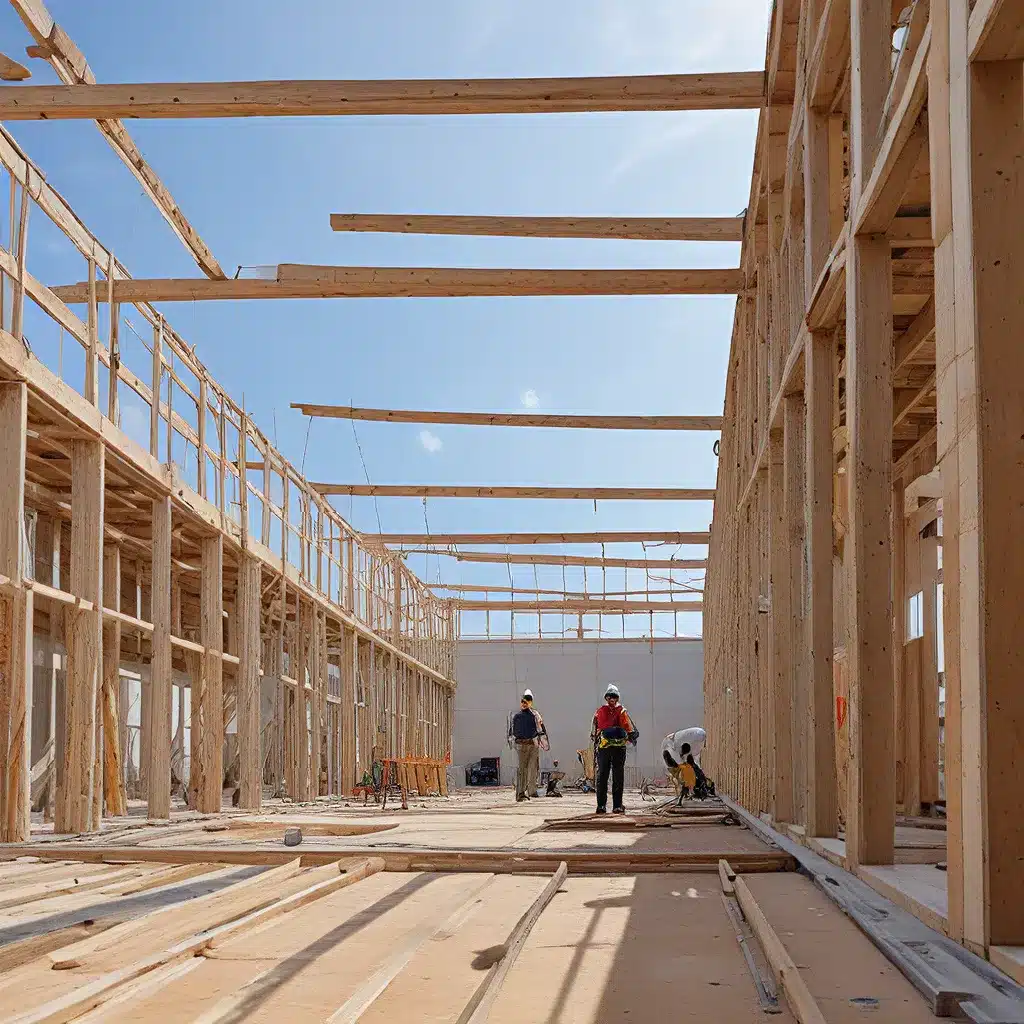
Buckle up, folks, because I’m about to take you on a wild ride through the world of prefabrication in general contracting. Now, I know what you’re thinking: “Prefab? Isn’t that just a fancy way of saying ‘Lego houses’?” Well, my friends, you’re in for a surprise.
The Prefab Revolution
In recent years, the construction industry has undergone a seismic shift, and prefabrication is at the heart of this transformation. It’s like a well-choreographed dance, where the steps are carefully planned, and the music is the sound of efficiency and cost-savings.
Let me paint you a picture: Imagine a construction site, where the traditional approach of laboriously hammering nails and mixing concrete has been replaced by a seamless symphony of pre-assembled components. These modular marvels are crafted in a controlled, factory environment, ensuring precision and quality that would make even the most meticulous contractor swoon.
But the benefits of this prefab revolution go far beyond just the aesthetics. As the Centre for Advanced Manufacturing of Prefabricated Housing beautifully articulates, this approach can unlock a world of possibilities when it comes to cost savings, sustainability, and project timelines.
Cutting Costs, Boosting Efficiency
One of the primary draws of prefabrication is the potential for cost savings. By leveraging the economies of scale and streamlined production processes in a factory setting, contractors can achieve significant cost reductions. The fact that you can reduce the schedule, compress it, shorten that critical path – that impacts costs, as Gil Manalo from Medxcel so eloquently puts it.
Imagine this: You’re working on a major expansion project for a hospital in Nashville. By incorporating just 5% of prefabricated elements, such as operating room ceilings, MEP racks, and headwalls, you’re able to shave off a whopping two months from the project timeline. That’s a savings of around $650,000 – a no-brainer if you ask me.
But the cost-saving potential doesn’t stop there. Prefabrication also minimizes the need for traditional on-site labor, reducing the amount of general conditions you have to pay. And as if that wasn’t enough, the controlled factory environment allows for better quality control, reducing costly rework and ensuring a seamless assembly process.
Sustainability: Building a Greener Future
In today’s world, where environmental consciousness is more important than ever, prefabrication offers a sustainable solution that would make even the most ardent eco-warrior swoon. By optimizing resource usage and minimizing material waste, these modular marvels are the construction industry’s version of a green superhero.
Imagine a world where the construction site is a veritable oasis of efficiency, with nary a scrap of wasted material in sight. That’s the beauty of prefabrication – it’s like a well-oiled machine, where every component is meticulously planned and executed to minimize the environmental impact.
And let’s not forget about the energy efficiency factor. The controlled factory environment allows for the integration of cutting-edge technologies and practices, ensuring that these prefab wonders are not only aesthetically pleasing but also environmentally friendly.
Faster, Safer, and Smarter
Speed, safety, and intelligence – that’s the holy trinity of prefabrication in general contracting. Imagine a world where your construction timeline is streamlined like a well-oiled Formula 1 car, where the on-site assembly is as smooth as a hot knife through butter.
By fabricating building components off-site, you can eliminate the need for traditional on-site labor, allowing for concurrent preparation work to be done in parallel. This means that your project can be delivered in a fraction of the time, reducing disruptions to surrounding communities and minimizing overall project risk.
But the benefits don’t stop there. The controlled factory environment also enhances worker safety, as employees are shielded from the hazards and unpredictable conditions of a typical construction site. And with the increased use of automation and data-driven processes, prefabrication is ushering in a new era of intelligent construction.
Overcoming the Challenges
Now, I know what you’re thinking: “Sounds great, but what about the challenges?” Well, my friends, it’s not all rainbows and unicorns. Prefabrication does come with its fair share of obstacles, but with the right mindset and a bit of elbow grease, these challenges can be overcome.
One of the biggest hurdles is the need for meticulous planning and coordination. Since the building components are fabricated off-site, ensuring that everything fits together seamlessly during on-site assembly is crucial. It’s like a high-stakes game of Tetris, where one wrong move can send the entire project into chaos.
And then there’s the logistical nightmare of transporting those massive modular units from the factory to the construction site. Navigating the narrow streets of an urban area or the winding roads of a remote location can be enough to make even the most seasoned project manager break out in a cold sweat.
But fear not, my fellow contractors. With the right strategies and a little bit of creativity, these challenges can be overcome. It’s all about building strong relationships with local labor resources, engaging with partners at the portfolio level, and aligning stakeholders on the plan from the very beginning.
The Future is Prefab
As I wrap up this journey through the world of prefabrication in general contracting, I can’t help but feel a sense of excitement for the future. This innovative approach to construction is transforming the way we build our cities and communities, and the potential is truly limitless.
So, what are you waiting for? It’s time to embrace the prefab revolution and unlock the full potential of this game-changing technology. Head on over to Reading General Contractor and let’s start building a brighter, more efficient, and more sustainable tomorrow, one prefab module at a time.
Related posts:
No related posts.




